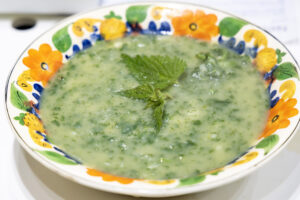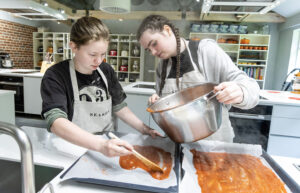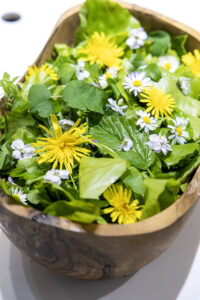Rustic Recipes Reimagined 2023
Rustic Recipes Reimagined – Recipes
Nettle Soup
Prepared from young fresh leaves of Common Nettle, Urtica dioica, from our College campus, this traditional soup will take you back to childhood Guide and Scout camps and experiencing the countryside.
Wash your nettles and blanch by cooking in boiling water for 90 seconds, before immediately plunging them into cold water – this will remove the sting!
Add butter or oil to a pan and heat, throwing in some onion and garlic to taste and cooking until softened. Feel free to add potato to thicken up the soup and create a creamier base. Add water to cover and boil until the potatoes are soft. Now is time to add the finely chopped nettles, and adjust the consistency with water or coconut milk.
Ingredients like lemon, ginger, or honey could be added to flavour – feel free to play around with this simple recipe!

Fruit Parchment
Also called Fruit Leather, this method of preparation and preservation uses up any glut of seasonal fruit crops. It remains usable for three months or longer.
To enjoy this historic method yourself, harvest and wash your ripe fruit, then mash up the flesh and stew until well mixed into a paste. Sieve and smooth it down on a baking tray lined with greaseproof paper. Heat to reduce the liquid level until dried into the resulting parchment or leather.
Roll up into a fresh piece of greaseproof paper and keep dry. This can be served and enjoyed on its own or with cheese or game meats.
Reference: Wright, R. The Forager’s Calendar, 2019, Profile Books.

Hedgerow Salad
Tantalise and refresh your taste buds with a flavoursome salad, using common weeds plus some hedgerow plants:
- Beech, Fagus sylvatica, very young leaves providing a fresh peppery element
- Ground elder, Aegopodium podagraria, young shoots. This plant was introduced in the UK by the Romans as a food source and reintroduced medicinally after The First Crusade. Known as Bishop’s Weed, it is also an anti-inflammatory for treating or preventing Gout
- Hawthorn, Crataegus monogyna, young leaves have a nutty flavour giving rise to one of its common names of “Bread and Cheese”.
- Chickweed, Stellaria media, fast growing with a fresh flavour
- Dandelion, Taraxacum officinale, young leaves have a spicy flavour to add interest

Nuts and Berries – Nature’s Nibbles
Correctly identify, pick, wash, and enjoy. The fruits and nuts below may be eaten raw:
Blackberries, Rubus fruticosus, a classic ingredient of crumbles and delicious when picked straight of the plant.
Hazelnuts, Corylus avellana, when harvested green they taste delectably sweet with earthy undertones. Wild Alpine Strawberry, Fragaria alpina, is ideal in pies, cakes, and cheesecakes. Delightful with a bowl of cream, as well as Wild Raspberry, Rubus idaeus!
Bilberry, Vaccinium myrtillus, a close relative of the Blueberry, V. corymbosum, is a much more intense, sweet, and tangy flavour than their comparatively milder cousins.
Wild Alpine Strawberry, Fragaria alpina, is ideal in pies, cakes, and cheesecakes. Delightful with a bowl of cream, as well as Wild Raspberry, Rubus idaeus!
Hawthorn Fruit, Crataegus monogyna, with a sweet but tart flavour, can be made into jams, jellies and syrups.
Wild Cherry, Prunus avium, is wonderful in crumbles and pies, as a dessert sauce or a deeply rich glaze for cooked meats.
Pine Nuts, Pinus spp., all pine trees produce nuts, but some have larger fruits than others. These are common in salads to introduce a mild, sweet, and buttery taste.
-
Sweet Chestnut, Castanea sativa, ripens in Autumn and can be put into stuffing at Christmas! Make sure to check the tree with an identification guide as Horse Chestnuts, unlike Sweet Chestnuts, Aesculus hippocastanum, are not edible.
Rowan, Sorbus aucuparia, freeze or cook before making into a jam rich in vitamin C and high in sorbic acid which allows it to be preserved longer than other fruits.
Crab Apples, Malus sylvestris, can be very tart when eaten raw so we recommended cooking and having in desserts, sauces and jams.
Whitebeam Berries, Sorbus aria, pick when wrinkly in Autumn, cook into jams or sauces to accompany meats.
Beechnuts, Fagus sylvatica, we recommend cooking Beechnuts, as eating too many raw can be poisonous. These are packed with protein and fat making them a high-energy snack. Simply crack open the outer shell to reveal the nut within.
Rosehips, Rosa canina, do not eat the hairy seed within, only the fleshy fruit. Freeze a day before using as this gives you a juicier and more tender fruit.
Walnut, Juglans regia, place the fallen fruits in a cool, dry location, to make them easier to crack open with a nutcracker – then cook into cakes or place in salads for a soft, crunchy addition.
Elderberries, Sambucus nigra, are well known for their edible uses. Its fruits are poisonous raw, but when cooked, can be made into divine jams and wines.
Eat Your Greens
Introducing Good King Henry, Chenopodium bonus-henricus, a perennial vegetable high in Vitamin C.
Use as follows:
- Leaves – use like spinach. Very young leaves can be eaten raw. Mature leaves should be boiled or steamed until tender
- Stems – use as asparagus substitute if cut less than 20cm high
The name refers not to kings of England but to elves in Saxon folk tales!
Source: Manor Farm Herbs Oxfordshire
Responsible Harvesting
We must take care not to upset the balance of nature by excessive or ill-formed harvesting.
Woodland Trust harvesting advice includes:
- Minimising damage and wastage – take no more than you plan to consume and stick to paths in public spaces
- Know what you are picking Only collect from plentiful populations
- Leave plenty behind – vital for wildlife survival and maintaining ecological balance
- Seek permission – all wild plants are protected under the Wildlife and Countryside Act (1981)
If done sensibly and with regard for wildlife, responsible harvesting can be a fun, educational and highly rewarding activity.